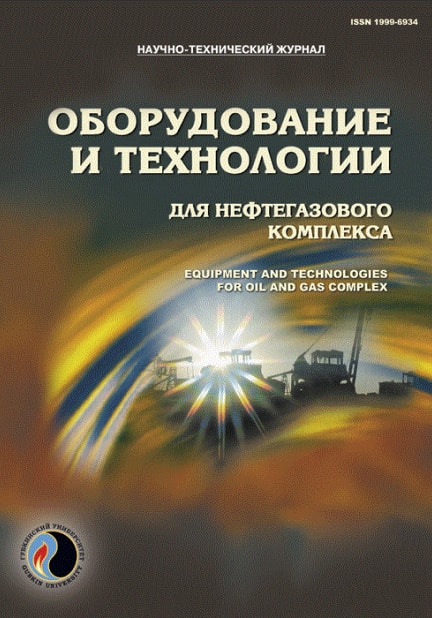Evaluation of the tubes the durability of the built-in heat exchanger of the ammonia synthesis column
UDC: 665.71:621.565.93/.95
DOI: 10.33285/1999-6934-2022-4(130)-5-9
Authors:
YASASHIN VITALY A. 1
1,
AGEEVA VERA N. 1
1,
KANAFEEVA DIANA I. 1
1
1 National University of Oil and Gas "Gubkin University", Moscow, Russia
Keywords: petrochemistry, natural gas, ammonia, ammonia synthesis column heat exchanger, corrosion, equipment residual operational life-time, quality
Annotation:
The gas chemical and petrochemical industries are one of the main priorities of the Russian economy development. Natural gas is the most demanded and affordable raw material in Russia. Ammonia obtained from natural gas, being the main component of gas chemistry, shows impressive growth rates of production today, which should be provided by modern technologies and equipment. The article examines the technical and technological aspects of the operation of ammonia synthesis columns. The features of the operation of the tubes of the built-in countercurrent shell-and-tube heat exchanger of the ammonia synthesis column are given. The approach to the formation of methods for calculating the residual operational life-time of heat exchanger tubes in terms of ensuring its quality improvement is analyzed.
Bibliography:
1. ITS 2-2019. Proizvodstvo ammiaka, mineral'nykh udobreniy i neorganicheskikh kislot. – Vved. 2020–03–01. – M.: Byuro NTD, 2019. – XII, 825 s.
2. Yasashin V.A., Dorofeeva M.V., Bolotokov A.S. Metodika sertifikatsionnykh ispytaniy kozhukhotrubchatogo teploobmennika s plavayushchey golovkoy. Sravnenie otechestvennoy i zarubezhnoy normativno-tekhnicheskoy dokumentatsii na teploobmennye apparaty // Upravlenie kachestvom v neftegazovom komplekse. – 2017. – № 3-4. – S. 34–38.
3. Yasashin V.A., Demidenko M.S. Analiz kachestvennykh kharakteristik kozhukhotrubchatogo isparitelya (reboylera) v proizvodstvennom tsikle szhizhennogo prirodnogo gaza // Oborudovanie i tekhnologii dlya neftegazovogo kompleksa. – 2020. – № 2(116). – S. 42–47. – DOI: 10.33285/1999-6934-2020-2(116)-42-47
4. Kanafeeva D.I., Yasashin V.A., Radaev G.V. Analiz putey povysheniya effektivnosti oborudovaniya neftepererabotki // Oborudovanie i tekhnologii dlya neftegazovogo kompleksa. – 2020. – № 3(117). – S. 52–55. – DOI: 10.33285/1999-6934-2020-3(117)-52-55
5. Obzor metodov ukrupnennoy otsenki ostatochnogo resursa oborudovaniya, ekspluatiruemogo na opasnykh proizvodstvennykh ob"ektakh / A.P. Bogdanov, A.A. Gaynullin, A.A. Efimov [i dr.] // Aktual'nye problemy gumanitarnykh i estestvennykh nauk. – 2015. – № 11-1. – S. 98–105.
6. Khademi M.H., Sabbaghi R.S. Comparison between three types of ammonia synthesis reactor configurations in terms of cooling methods // Chemical Engineering Research and Design. – 2017. – Vol. 128. – P. 306–317. – DOI: 10.1016/j.cherd.2017.10.021
7. Vorob'ev N.I. Tekhnologiya svyazannogo azota i azotnykh udobreniy: teksty lektsiy po odnoimennomu kursu dlya studentov spetsial'nosti 1-48 01 01 "Khimicheskaya tekhnologiya neorganicheskikh veshchestv, materialov i izdeliy" spetsializatsii 1-48 01 01 01 "Tekhnologiya mineral'nykh udobreniy, soley i shchelochey" ochnoy i zaochnoy form obucheniya. – Minsk: BGTU, 2011. – 216 s.
8. Kazakov V.S., Alekseev A.S. Diagnostirovanie i otsenka ostatochnogo resursa ekspluatatsii teploenergeticheskogo oborudovaniya // Vestn. Bryanskogo gos. tekhn. un-ta. – 2015. – № 2(46). – S. 32–39.
9. Oreshkin A.Yu., Shlyachkov D.A., Yushkov A.B. Osnovnye problemy metoda otsenki iznosa tekhnologicheskogo oborudovaniya khimicheskikh, neftekhimicheskikh i neftepererabatyvayushchikh proizvodstv dlya obespecheniya promyshlennoy bezopasnosti opasnykh proizvodstvennykh ob"ektov // Molodoy uchenyy. – 2015. – № 12(92). – S. 270–273.
10. Ryabov A.A. Obzor sushchestvuyushchikh metodov otsenki ostatochnogo resursa oborudovaniya neftegazopererabotki // Elektron. nauch. zhurn. Neftegazovoe delo. – 2016. – № 1. – S. 198–220.

